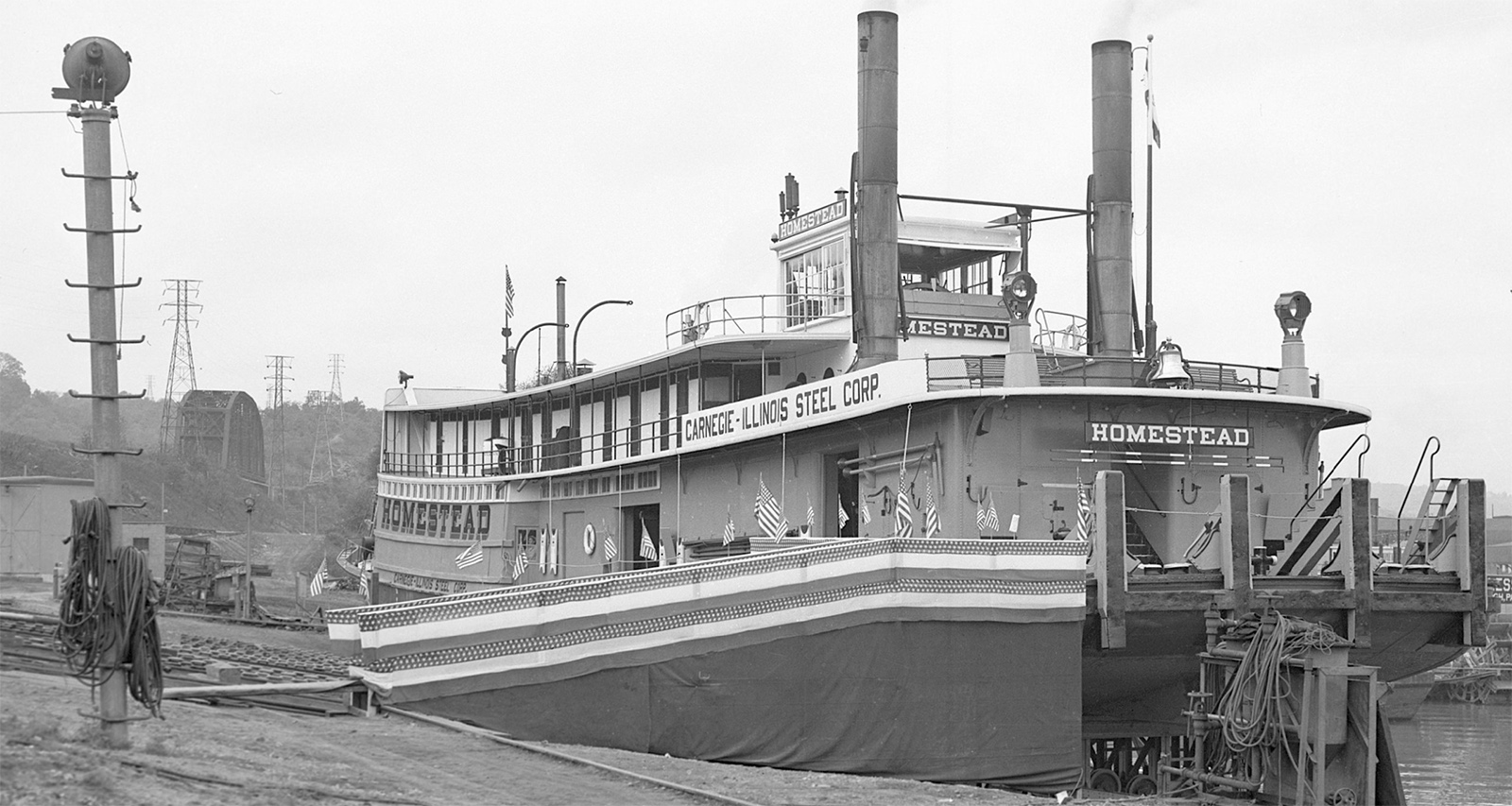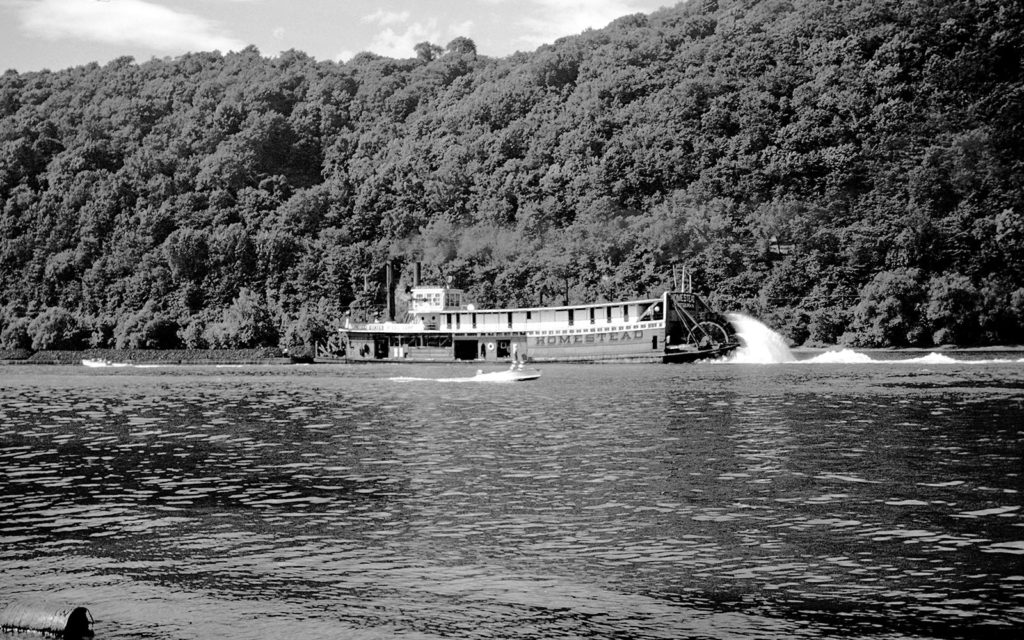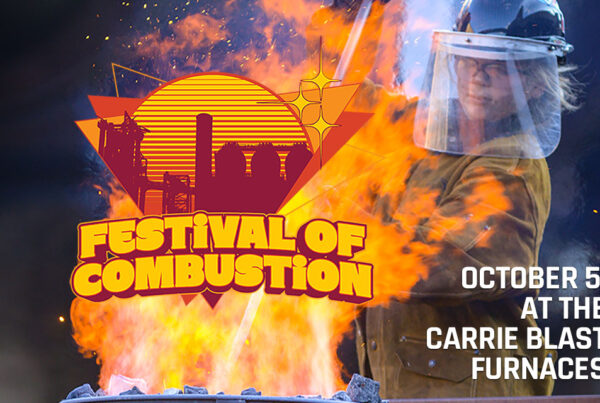
By Brianna Horan | Image: The Christening of the Homestead, October, 1945. From the University of Pittsburgh’s William J. Gaughan Collection.
 The Steamboat Race of the Century
The Steamboat Race of the Century
In 1949, tens of thousands of Pittsburghers lined the riverbanks of the Ohio and Monongahela rivers, packed onto bridges, and peered out of skyscraper windows to watch the “steamboat race of the century.” This friendly competition between two steam-powered tow boats owned by United States Steel Corp. and Jones & Laughlin Steel Corp. carried serious bragging rights for the winner, and the photo finish was hotly contested.
Luckily for those of us who missed the race 71 years ago, a radio broadcast from announcers riding along on U.S. Steel’s Homestead still exists today, with a minute-by-minute recap of the action, a cacophony of cheering boat horns, and even a “hoowee” of glee from Charles R. Cox, president of the U.S. Steel Carnegie-Illinois Steel Corporation.
Take a listen to part one of the broadcast here, and hear the exciting finish here. The two audio files are about 9 minutes long all together. You can also read the Pittsburgh Sun-Telegraph’s recap of the events here, and a profile of the 49-year-old fire boss whose sweat and brawn secured the win for his sternwheeler can be read here.
The West End Bridge over the Ohio River served as the starting line, where the gun went off at 11:51 a.m. to start the race. The two sternwheel towboats, U.S. Steel’s Homestead, built in Ambridge in 1922, and Jones & Laughlin Steel Corp.’s William Larimer Jones, built in Indiana in 1930 and named for the president of J & L, were both pushing four empty barges in front of them as they plowed towards The Point and veered right to head up the Mon. The Homestead quickly pulled to the lead, with the radio broadcasters onboard remarking, “Have you ever seen water boil and flow underneath barges like this?!” They describe the May weather as overcast, cool and cloudy, and note that they can’t see behind them because of the black smoke pouring out of the two vessels.
The race heats up as the sternwheelers reach The Point Bridge, a structure that spanned the Monongahela close to where the plaza around The Point’s fountain is, and was demolished in 1970. The Sun-Telegraph reported that the Homestead suddenly dropped behind, “while the black smoke pouring from its double stacks thinned to a haze.” Meanwhile, Jones & Laughlin’s “gleaming, single-stacked William Larimer Jones shoved its black barges into the lead in the stretch.” The broadcasters onboard the Homestead audibly deflate, and they point out that deckhands on the William Larimer Jones, “are waving their hands and jumping around, they are really excited and they are calling remarks back and forth.” By this point, the Jones’s staff of stewardesses, clad in white uniforms, have started to cheer, as well.
But as the finish line—the Smithfield Street Bridge—draws near, the Homestead had regained its slight lead. There’s an exuberant whine of boat horns in the audio recordings cheering along with what the broadcasters estimate to be 200,000 spectators. The recordings capture the roar of the William Larimer Jones blowing off its build-up of steam.
The “see-saw race” of 1.5 miles ends at noon in a photo finish. It’s so close that the deckhands and distinguished guests onboard both vessels erupted in celebration, each thinking that they had come in first place. The broadcasters can’t be sure who’s won, but get word that the judges, one of whom is Mayor David Lawrence, declared U.S. Steel’s Homestead sternwheeler the winner. The steamer’s Captain, Richard Hanna, was gifted a bouquet of roses and “an ornate captain’s cap” from the presidents of both steel manufacturers. After the race, a victory dinner was served onboard the Homestead while it took a “triumphal tour of the harbor.”
The Sun-Telegraph quoted the William Larimer Jones’s Captain William D. McConnell saying after the race, “They’ll be arguing the decision of this race for the next 100 years. And when the deckhands get together in a bar there’s sure to be a fight about who won.” The newspaper also reported that their newsroom was inundated with calls contesting U.S. Steel’s victory.
But the Homestead’s recapturing of the lead becomes even more impressive when it’s revealed that unbeknownst to the rest of the crew, the boat’s steam regulator valve failed midway through the race, and cut off the automatic stoker engines. Realizing what happened, the steamboat’s firemen, Ed Berry of Rices Landing and Jesse Beckner of Carrick, began a frenzied shoveling of “more than a ton of coal into the four raging boilers of the Homestead during the last minutes of the race.” A later interview with Beckner, a 49-year-old weighing in at 245 pounds and standing six feet tall, quoted him saying that it was “the Lord’s will” that brought them victory—although he also admitted that the $20 wager he’d put on the Homestead was also a strong motivator.

United States Steel’s sternwheel towboat, the Homestead, pushing coal or coke. Mid-20th-century image from the collection of Rivers of Steel.
This steamboat race was the crowning event of Pittsburgh’s Welcome Week, hosted by the city’s Chamber of Commerce to show off what was being touted as “America’s busiest city” to draw more businesses and residents to town. The two steel companies had a rematch during the 1950 Welcome Week, and the winner was even announced in the New York Times—the Homestead won again, racing against J&L’s Titan. While Welcome Week lasted only a few years (Pittsburgh saw its last steamboat race in 1951), the city’s affinity for boat racing would later push the Pittsburgh Regatta, which debuted in 1978, to become the largest inland regatta in the country before going on hiatus in in 2019, when the iconic event was cancelled because the event management company failed to secure the necessary insurance.
As for the mighty Homestead, it worked in service to the company until 1960 when it was dismantled. It met that fate despite calls from some locals to covert it a tourist attraction…perhaps a early indicator of our region’s reverence for its industrial history—a notion we at Rivers of Steel wholeheartedly embrace today.

 The Steamboat Race of the Century
The Steamboat Race of the Century





